All Warmed Up: The Early Days of Car Heaters
With much of the United States and Canada recently in the icy grip of a polar vortex, and many regions experiencing sub-zero temperatures (that’s 0 degrees on the Fahrenheit scale, about minus 18 on the Celsius scale for you folks north of the border), it may be an appropriate time for a look into the history of car heaters.
The first motorcars, appropriately termed horseless carriages, were generally open, and like horse-drawn carts and wagons they had no protection from the elements. “Brass era” publications show advertisements for “automotive apparel,” i.e. heavy coats, gloves, and hats, as well as “storm aprons,” essentially ponchos big enough to cover all of the passengers.

You may note that Margaret A. Wilcox was the first to invent a car heater, and that’s true, in a manner of speaking. While she did patent a system that directed air through the engine, heating it, and then routing it to the passenger compartment, the “cars” her 1893 invention warmed were railroad cars, not automobiles. I suppose that conceptually it is the basis for the way early motorcars and later air-cooled automobiles pulled passenger compartment heat from heat exchangers on the exhaust system, but I doubt Ms. Wilcox ever saw an automobile before she filed her patent application. The system did warm railroad passengers, but it was relatively primitive. Without the system they froze; with it, they were roasted.

Depending on which source you read, it was either Cadillac in 1906 (or 1907 per some sources) or Hudson in 1913 that first introduced a fully-enclosed automobile. To keep warm, early motorists did what they had done with animal-powered conveyances; they would preheat bricks or soapstone on the oven at home and place them in dedicated hotboxes inside the passenger compartment.
If you think heated steering wheels are a modern accessory, you might be surprised to know that some early electric car builders wrapped heating elements around their steering wheels.

An improvement over hot bricks was the introduction of portable coal-burning heaters, made of galvanized iron with asbestos linings and brass handles for portability. A purpose-manufactured brick of coal (or charcoal) was placed in a drawer in the heater after it was prepared for use in a live fire, presumably a wood- or coal-fired oven at home. After the flame died down, the hot coals were said to burn without odor or smoke. Fortunately, even though automobiles were being enclosed, they weren’t very airtight, so perhaps carbon monoxide from the burning coal wasn’t an issue. One brick was said to be able to heat the passenger compartment for several hours. When heat was no longer needed, the hot coal could be doused with water and reused later.

Such portable heaters required preparation ahead of time as well as moving the coals and heaters in and out of the cars. On-board heaters would be much more convenient. Since many early automobiles were air-cooled, attention was given to recovering waste heat from the exhaust system. At least as early as 1907, exhaust gas heaters were sold as automotive accessories. As seen in a period advertisement, one of those designs incorporated a metal jacket around the muffler through which air could be heated and supplied to the passenger compartment via grates in the floor.
In some cases the cabin was heated passively, through convection, and in other cases air was forced through the system, either with an air intake funnel behind the engine fan or actively with an electric blower. A more sophisticated heat exchanger design routed the exhaust gases through bundles of tubes. Heat could be controlled in very rudimentary fashion with valves whose handles were typically mounted on the car floor. Those valves controlled the flow of exhaust gas through the heat exchangers.

As an aftermarket accessory, these early heaters were not very practical. They were hard to retrofit into existing passenger compartments, and sometimes leaked exhaust into the cabin, causing some deaths due to carbon monoxide poisoning. A safer way of using the engine’s waste heat was with manifold heaters, popular with Ford Model A owners. A cast iron duct routed air over the exhaust manifold and into the cabin via a port in the firewall. Enough Model As are still on the road that manifold heaters are still being made, though now they are made of aluminum.
In 1933, after it introduced V-8 power for the masses, Ford developed an in-dash heater for those cars, though it still used exhaust as a heat source. Constructed like steam boiler, hot exhaust was directed into two dozen 13-inch-long flues around which flowed fresh air. The outlet of the heater was installed in the dashboard in front of the passenger. A button at the driver’s feet regulated the heat via an intake valve upstream of the flues.
None of the early exhaust-based heaters had provisions for mixing fresh air with the heated air, so in 1940, Ford had Novi Equipment develop an integrated manifold heater that could mix the heat with fresh air.

Also in the mid-1930s, General Motors’ Delco division developed a clever heating system that duplicated the steam radiators used to heat many homes and buildings. A boiler was located at the outlet of the muffler. The boiler was charged with a very small amount of water, just one ounce, so when the car was started, the heat from the 900°F (482°C) exhaust gases would immediately vaporize that water into steam, causing it to rise into the heater core where an electric fan would blow the heat into the cabin. From the heater core, the steam pipes routed the water vapor through the car’s radiator to condense it back to water.
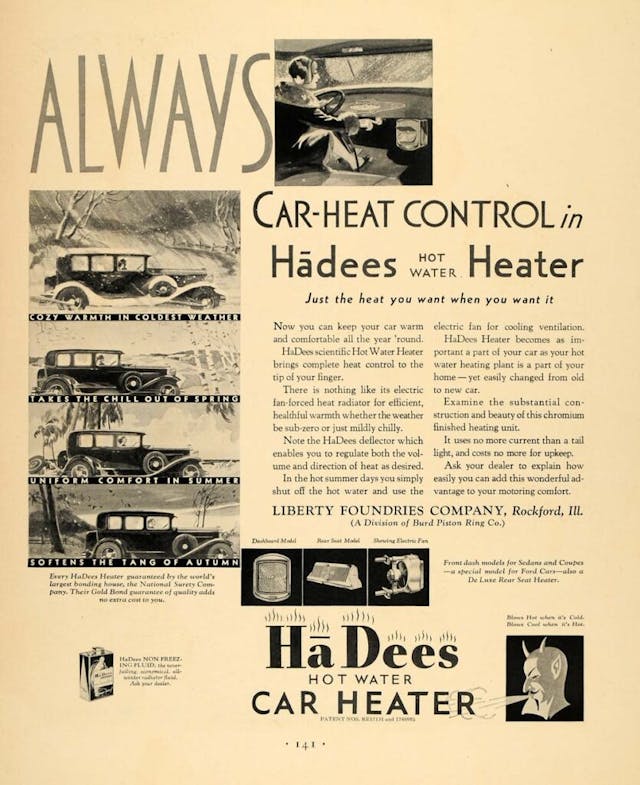
If you are wondering why the auto industry didn’t use the hot water in the cooling systems of water-cooled engines, that’s because exhaust-based heaters could discharge heat at a quite toasty 200°F (93°C) and exhaust gases are hot as soon as you start the engine, unlike engine coolant that has to heat up. However, by the mid 1920s, water pumps and thermostats had gotten reliable enough at regulating engine temperature to allow for hot coolant to be used to heat the passenger compartment. The first coolant-based heaters were aftermarket devices, and it wasn’t unusual for owners to transfer their heaters when they replaced cars.
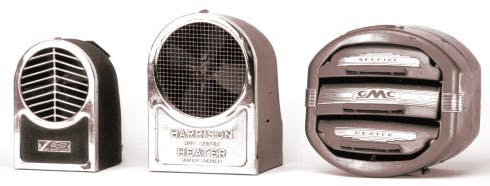
In the winter of 1927-28, A.B. Arnold fabricated a prototype hot water heater for the Ajax car owned by another Arnold whose initials were also A.B., Arnold B. Modine. Modine had founded Modine Manufacturing in 1916, first making the Spirex-branded radiator for tractors and then supplying Ford with the Turbotube radiator for Model Ts. Incidentally, it was Modine Manufacturing that built the first vehicular wind tunnel in 1941, to test radiators and car heaters.
Modine attributed his success to his insight that the key to managing heat in liquid-cooled engines was focusing on heating the air passing through the radiator, rather than concentrating on lowering the temperature of the coolant. A.B. Arnold took a honeycomb heater core, mounted it under the dashboard and plumbed it into the engine cooling system so that the hot coolant flowed through the core on its way to the radiator, where it would be cooled. The system impressed Modine enough that he started to manufacture it to sell to automakers.
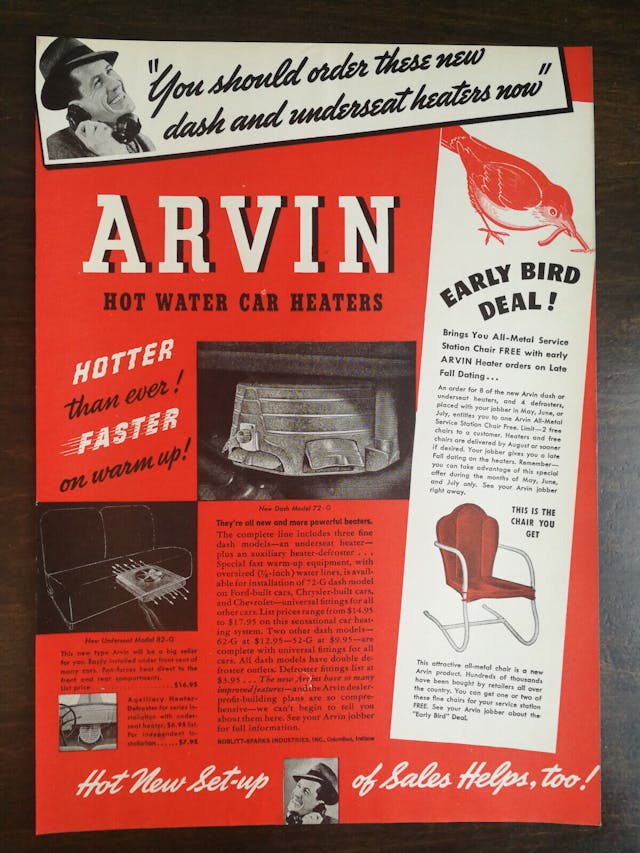
The Trane and Fedders companies, which you may recognize as makers of HVAC equipment, joined Modine in selling hot water-based car heaters, as did brands like Arvin and Ha-Dees (back in the ’30s, it was much more polite to say “hades,” than, “hell”). Major retailers like Sears and Montgomery Ward also sold aftermarket hot-water heaters. As with the Ford manifold heaters, you can buy reproductions for your period-correct restoration.
General Motors got into the picture with coolant-based heaters designed by Carl Darrah at Harrison Radiator Division, and in 1931 they introduced a heater for the rear passengers built into a footrest. Modine introduced a similar footrest design that was one of the first to mix fresh air from outside the car with the heated air. In 1933, A.B. Arnold also addressed the issue of fresh air by ducting heated air from the cowl ventilator on a Ford V-8 to the heater core mounted behind the instrument panel and then routing it from the heater core to the windshield, thereby apparently inventing the defogger.

In 1937, Nash added cabin pressurization to the mix. Filtered air was forced into heater and then to the passenger compartment, creating slightly higher air pressure inside the car. This prevented cold air from seeping in through various routes into the cabin.
It should be noted that with all of those advancements, most automakers did not offer heaters as standard equipment. It wasn’t until 1962 that hot water-based heaters became standard equipment on General Motors cars (well, except for the air-cooled Corvair, which had air forced over heat exchangers built into the exhaust system, similar to air-cooled Volkswagens and Porsches), and it wasn’t until 1968 that automakers stopped making heaters optional equipment. Newly-adopted Motor Vehicle Safety Standards required some kind of heated windshield defrosting system and the only way to do that was making heaters standard.
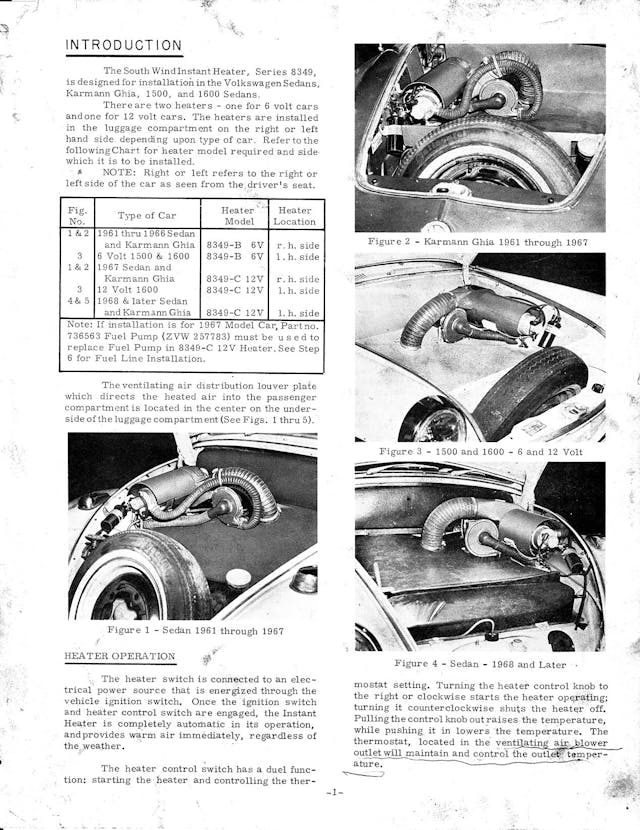
Owners of some of those air-cooled VWs, as well as over-the-road truckers, might be familiar with another heating system. In the late 1930s, the Stewart-Warner company developed a gasoline-burning passenger car heater and in the early ’60s. Working with GM’s Harrison division, they developed a gasoline-fired heater for the Corvair. Essentially a self-contained furnace, it delivered near-instantaneous heat in ample quantities. Stewart-Warner’s Southwind brand advertised them as heating up within 90 seconds. S-W sold them for Volkswagens, as did Germany’s Eberspacher. Nothing will warm the inside of a car faster than a gas-fired heater. Over-the-road truckers have used similar gas-fired heaters to keep their sleeper compartments warm without having to idle their engines for hours.
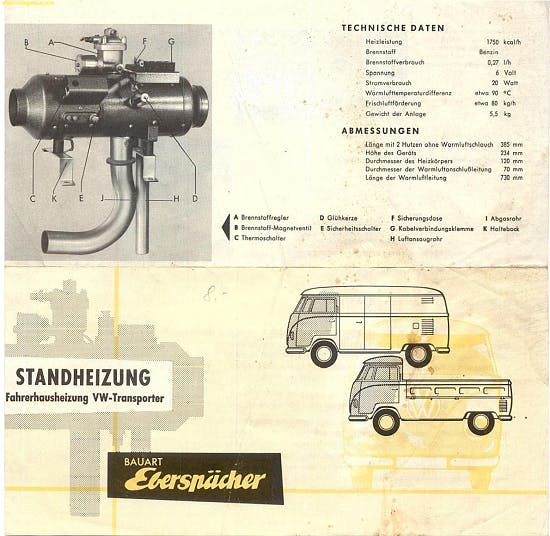
Developments like air conditioning and automatic climate control followed, and perhaps when the weather heats up this summer, we’ll take a look at the history of automotive A/C (short form: Packard, 1939). But in the meantime, if the weather outside is frightful, but inside your car it’s still delightful, you can thank folks like A.B. Arnold, A.B. Moline, Carl Darrah, and maybe even Margaret Wilcox.
***
Check out the Hagerty Media homepage so you don’t miss a single story, or better yet, bookmark it. To get our best stories delivered right to your inbox, subscribe to our newsletters.
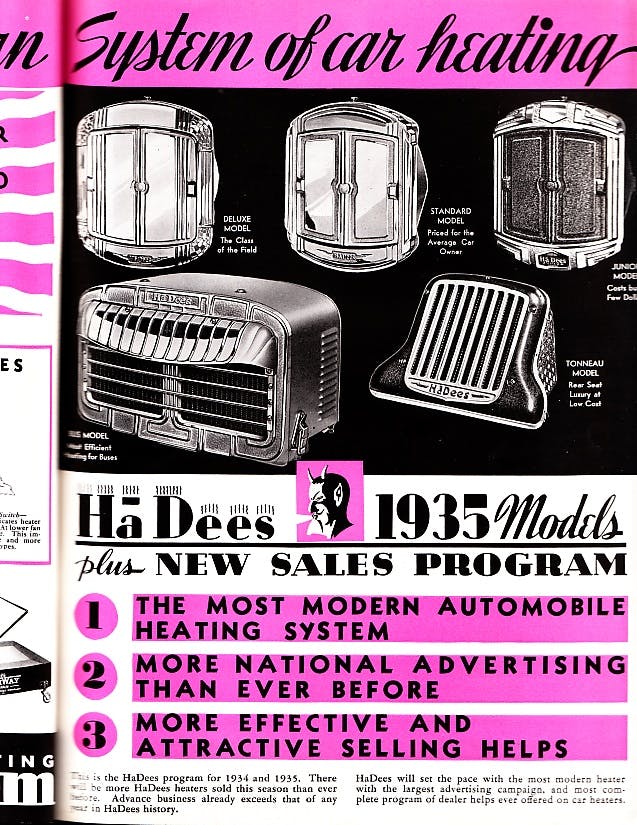


We had a 1961 bug when we married in 1967. It had a gas heater and did just fine in our Montana winters. I had a 55 Chevy in high school and it not only had heat, but factory air. I hated that huge Harrison air box on the right side of the engine compartment.
Great article!
My 1979 Beetle convertible came with the optional gasoline heater, and it worked great: fast and powerful. It had only an on-off switch, though, but that was not a problem. By the time the gas heater warmed the car well, the engine had warmed sufficiently to keep the inside warm with the usual VW heat exchanger setup, so I would switch off the gas heater. Some folks were afraid of a gas heater, but the VW one seemed quite well-engineered, as well as relatively compact. And since I am cold-natured, I used that gas heater a LOT!
With all the talk about VWs, I should mention the heater that I made for a ’72 Type II aka The Magic Bus. I made a slightly high-performance 1648cc engine with a high pressure oil pump and an external oil filter (air-cooled VW engines had a screen in the bottom of the crankcase, not an oil filter). I also added an auxiliary oil cooler on the roof to keep engine temps reasonable at highway speeds (people would ask me what the little radiator on the roof was and I’d say, “It’s an oil cooler.” They’d reply, “What does it do?” “Umm, cool oil.”). Since I was already routing the oil out of the engine, I got an OEM Type I “doghouse” oil cooler, built a plenum around it with some sheet aluminum, hung a 12V squirrel fan on it and stuck the assembly in the spare tire well in the back deck above the engine. I added some manual valves so I could route the hot oil to the cooler in summer and the DIY heater in the winter. I won’t say that it made things toasty but the interior of the bus was warm enough for our kids in cold Michigan weather, about 60-65 degrees.
I remember my friend Steve’s Beetle in High school. The way you defrosted the windshield was for the driver and passenger to both blow into their cupped hands and then place all four of your palms on the windshield. It was not an overly efficient procedure…
My Dad’s 1953 Pontiac had a heater and his 55 Olds. The 1952 chev that my friend owned also had a heater. Maybe it was different for cars sold north of the 49th parallel. All of the cars my family owned from 1946 to now had heaters in them.
Started driving in ’69. Always, while perusing the classified ads for my next junker, the listings would often say “R&H” (radio and heater) Always wondered what that was about. Didn’t all cars come with at least a heater. Apparently not. Thanks for the education. BYW, the best one I owned was in an MG 1100. It would start making heat by the end of my driveway. Also my 96 LT1 powered Roadmaster Wagon with the reverse flow cooling system.
Buick had an under seat water heater including an under dash water heater for the windshield defroster. Both had blower fans. They were standard equipment on 80 ,90 series and convertible sedans in 1940 and optional on smaller series models.
Back in my younger days, 1940’s and 1950’s. My Uncle had a 1936 Ford coupe with an accessory gasoline heater. Man that thing would roast you. It seems to me he would light it with a match. Seems sort scary in retrospect.
In 1958 I got my first car, a 1950 Ford two door sedan. During the winter in Erie, PA it would be pretty cold. My windshield defroster was to drive with the windows down. That way the temperature was equalized on both sides of the glass and no fog or frost was formed. Pretty crude but worked.
My first car, a ’47 Ford Deluxe Coupe, had a Southwind gasoline heater under the dash, and it was terrific. I still remember one day, parking with my “high school honey” in a heavy snowstorm, with the heater keeping us cuddly until the snow covered the whole car, blocking out the light. We’ll end the story there.
My second car, a ’52 MG-TD, had no heater at all…or radio…or reliable windshield wipers…but I was young then.
I had a ’69 VW bug with an after market gas heater and when operating, its exhaust pipe got red hot. When I realized that pipe touched the fill pipe of the gas tank I got rid of the car.
What..no comments on the Army Jeeps? You had a canvas top and rear cover to keep off the rain, No side curtains. doors, and NO HEATERS were authorized unless you were in designated cold climate area. You had to bundle up in the winter even in southern States. If you wore glasses, you needed a defroster for them.
I had a ’48 Morris Minor Series MM conv. with the 948cc flathead 4 cylinder.
It used thermo-syphon cooling and did not have a water pump for water circulation.
For cold climates there was an accessory water pump that bolted to the block next to the engine and could be plumbed into the upper and lower radiator hoses with small rubber “T” taps to provide hottish water to the accessory heater core.
That must be why everyone wears heavy coats in British movies.